Most Eco-Friendly Cryptocurrencies to Invest in 2023

Disclaimer: The Industry Talk section features insights by crypto industry players and is not a part of the editorial content of Cryptonews.com.
Global warming has become one of the most pressing issues in today’s world, prompting many companies to implement sustainability practices. This is no different in the crypto market, with an abundance of eco-friendly projects springing up that look to reduce their energy consumption and make a positive impact on the environment.
In this guide, we’ll discuss 12 of the most eco-friendly cryptocurrencies on the market, exploring the technology that enables them to operate sustainably, before highlighting several strategies investors can use to identify eco-friendly crypto projects.
The 12 Most Environmentally-Friendly Cryptocurrency Projects in 2023
Listed below are 12 of the most sustainable cryptocurrency projects this year, each thoroughly vetted to ensure they positively impact the environment. We'll explore these eco-friendly cryptocurrencies in detail in the following section, covering their underlying technologies and future roadmaps.
- C+Charge (CCHG) – Most Eco-Friendly Cryptocurrency in 2023 Offering Rewards to EV Drivers
- IMPT (IMPT) – Exciting Carbon Offsetting Project Now Listed on Exchanges
- Tezos (XTZ) – Popular Eco-Friendly Crypto in 2023
- Ethereum (ETH) – Environmentally Friendly Crypto with Low Energy Requirement
- Solana (SOL) – The Most Environmentally-Friendly Crypto in the Blockchain Sector
- IOTA (MIOTA) – Eco-Friendly Network in the ‘Internet of Things’ Space
- Hedera (HBAR) – Environmentally-Friendly Alternative to Blockchain Technology
- Chia (XCH) – ‘Green’ Blockchain with Unique Consensus Protocol
- SolarCoin (SLR) – Innovative Platform Incentivizing Solar Power Generation
- Polkadot (DOT) – Eco-Friendly Protocol Designed for Interoperability
- Flow (FLOW) – New Low-Energy Blockchain for NFT Creators
- Algorand (ALGO) – Carbon-Negative Blockchain with Environmentally-Conscious Founder
Cryptoassets are highly volatile and unregulated. No consumer protection. Tax on profits may apply.
A Closer Look at the Most Eco-Friendly Cryptos to Invest
When looking for the most energy-efficient cryptocurrency, investors must ensure that the development team places sustainability on their list of priorities. Projects where this is the case will often employ leading technologies to reduce their energy requirements – or even offset their carbon footprint completely.
With that in mind, let’s dive in and explore the most eco-friendly cryptocurrency projects on the market right now:
1. C+Charge (CCHG) – Most Eco-Friendly Cryptocurrency in 2023 Offering Rewards to EV Drivers
C+Charge is our most eco-friendly crypto for 2023 as it is offering carbon credit rewards to incentivize drivers to switch to electric vehicles (EVs).
The project, which has only just launched the first stage of its CCHG token presale, will also develop a mobile app designed to take the inefficiencies and inconveniences out of EV ownership.

While EV sales have boomed in recent years, the majority of vehicles on the road are still powered by fossil fuels, with many drivers put off by the difficulties of recharging EVs.
C+Charge will attempt to solve those issues by not only incentivizing EV ownership but by offering information on recharging stations - including waiting times and pricing.
The rewards come through carbon credits, which are permits that allow the holder to offset their carbon footprint by funding eco-friendly projects, with one credit equalling one ton of CO2 emissions.
C+Charge has partnered with green project Flowcarbon - which secured $70 million of investment from major VC firms such as a16z and Invesco - to offer Goodness Nature Tokens (GNT) which are 1:1 backed by carbon credits from verified carbon regeneration projects.
C+Charge will also democratize carbon credit ownership, with the asset class currently dominated by big businesses.
Tesla, for example, make billions annually selling carbon credits to less eco-friendly companies, who use them to offset their own large carbon footprints.
The C+Charge mobile app will also make EV ownership more convenient and efficient as it provides detailed information on waiting times, pricing and diagnostic data on charging points.
As it stands, EV drivers often arrive at recharging points to find long queues, huge variances in pricing and, often, broking charging stations. The CCHG token will be used to pay for recharging at a uniform price and is now on sale for $0.013 each in the first of four presale stages.
By the time of the fourth and final round, CCHG tokens will have increased in price by 80% to $0.0235. Of the 1 billion max supply, 40% of tokens will be available during the presale with no vesting period and a hard cap of $6.6 million.
More information can be found in the C+Charge whitepaper or in the Telegram group.
| Phase | Price | % of presale tokens | Number of Tokens | $ Value |
| 1 | $0.0130 | 40 | 160,000,000 | $2,080,000 |
| 2 | $0.0165 | 30 | 120,000,000 | $1,980,000 |
| 3 | $0.0200 | 20 | 80,000,000 | $1,600,000 |
| 4 | $0.0235 | 10 | 40,000,000 | $950,000 |
| TOTAL | 80% increase | 100% | 400,000,000 | $6.6 million |
2. IMPT (IMPT) – Exciting Carbon Offsetting Project Now Listed on Exchanges
Another carbon credits ecosystem, IMPT, is also drawing huge interest in the crypto space as one of the most eco-friendly projects around.
IMPT is one of the most talked-about projects in this niche due to the platform's innovative approach to carbon credits trading - and sold more than $20 million of tokens during a much-hyped presale.

Now listed on Uniswap and LBank - with listings on BitMart, Changelly Pro and others to follow in the coming weeks - IMPT is expected to break out in price in 2023.
IMPT is the native token of the IMPT ecosystem, used for all marketplace transactions. This means that carbon credits can be bought, sold, and traded using IMPT, providing the foundation for a self-sustaining marketplace where the laws of supply and demand determine prices.
However, where IMPT really excels is in how the platform makes these carbon credits accessible to the masses. Over 10,000 popular brands - including the likes of Nike, Samsung and Amazon - have partnered with IMPT and dedicated a portion of their sales margin to impactful projects.
This means that when IMPT users buy goods and services from these brands, they will be rewarded with IMPT tokens.
Since these IMPT tokens can be exchanged into carbon credits, this essentially means that users can acquire credits through their everyday shopping activities. According to IMPT’s whitepaper, the value of these credits is expected to rise in the coming years due to increased global demand. This helps incentivize users to shop with IMPT’s partner brands, providing benefits for all parties.
If an IMPT user wishes to boost their positive impact, they can also opt to ‘retire’ their carbon credit NFTs. This takes the credit out of circulation and essentially ‘removes’ CO2 from the atmosphere. In return for this, the user will be rewarded with a unique digital artwork NFT, which can be traded on IMPT's built-in marketplace.

IMPT doesn't stop there, as the project also incorporates social networking elements which sees an 'IMPT Score' given to all users. The more impactful a user is, the higher their IMPT Score. Interestingly, these IMPT Scores are publicly viewable, incentivizing users to boost their environmental impact to increase their score.
Those looking to learn more about IMPT, which is built on energy-efficient Ethereum, can do so by joining the project's official Telegram group.
3. Tezos (XTZ) – Popular Eco-Friendly Crypto in 2023
Tezos has made a name for itself in the past year through high-profile partnerships with Manchester United and McLaren Racing, helping raise awareness of this exciting project. This awareness has helped Tezos’ team expand the network and make it more eco-friendly.
Tezos’ recent TezDev Conference saw the development team highlight plans to make the network capable of handling an incredible one million transactions per second (TPS) in the coming years. This will be achieved with sustainability in mind since the Tezos network uses the same amount of energy per year as just 17 global citizens.

These elements have made Tezos one of the most searched crypto projects on the market, with investors also appealed by the development team's assertion that the network will use less power as it grows. Finally, Tezos' team even provides accurate emissions data for the blockchain every month – with emissions clearly trending lower as the years have gone on.
Cryptoassets are highly volatile and unregulated. No consumer protection. Tax on profits may apply.
4. Ethereum (ETH) – Environmentally Friendly Crypto with Low Energy Requirement
Another of the most eco-friendly cryptocurrencies to be aware of is Ethereum. For the longest time, Ethereum used the ‘Proof-of-Work’ (PoW) consensus mechanism, which relies on energy-intensive ‘mining’ to secure the network. However, Ethereum has recently transitioned to a ‘Proof-of-Stake’ (PoS) consensus mechanism, which uses much less energy.
Due to this change, Ethereum has been touted as the next cryptocurrency to explode, as the network now uses 99.9% less energy than before. What's more, Ethereum's team now clearly focuses on sustainability, even calling the network a 'green blockchain'.
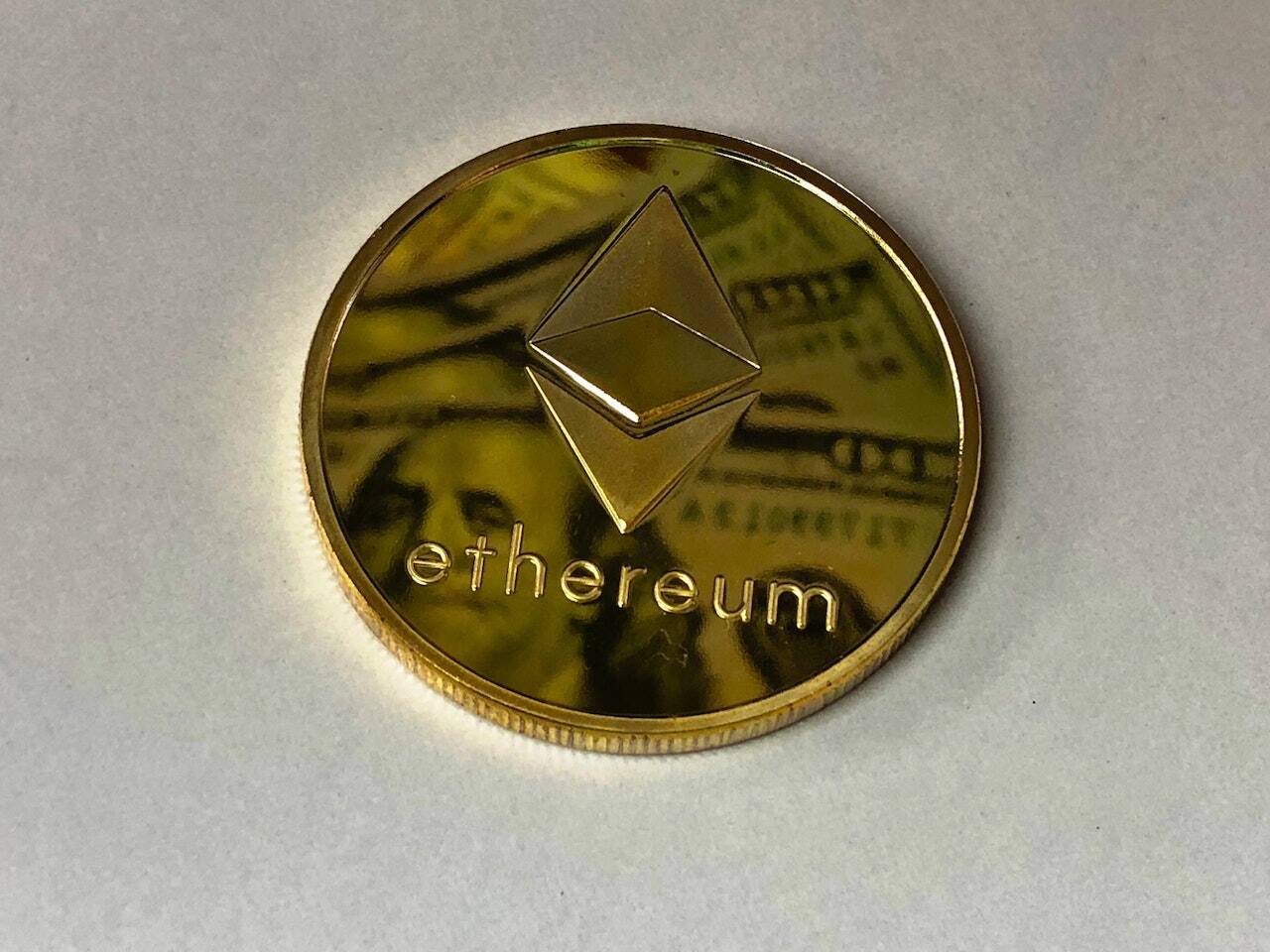
This eco-friendly crypto also offers additional benefits to investors since moving to a ‘greener’ consensus mechanism, such as the ability to generate a yield through staking. What’s more, Ethereum’s team plans to implement a ‘sharding’ approach sometime in 2023. This approach will make the network even more efficient and accessible – helping boost its positive environmental impact.
Cryptoassets are highly volatile and unregulated. No consumer protection. Tax on profits may apply.
5. Solana (SOL) – The Most Environmentally-Friendly Crypto in the Blockchain Sector
Solana is one of the few environmentally-friendly cryptocurrencies that looks to improve on the services offered by the Ethereum network. Like Ethereum, Solana is a smart contract-enabled blockchain that provides a foundation for decentralized app (dApp) developers and NFT creators. However, Solana is much more scalable due to its unique consensus algorithm.
This algorithm is a hybrid of PoS and 'Proof-of-History', meaning that the Solana network can reportedly handle 65,000 TPS, with each costing less than a fraction of a penny. Solana can also be considered an eco-friendly crypto since one Solana transaction uses just 3,290 Joules of electricity. To put this into perspective, this is less than four Google searches.
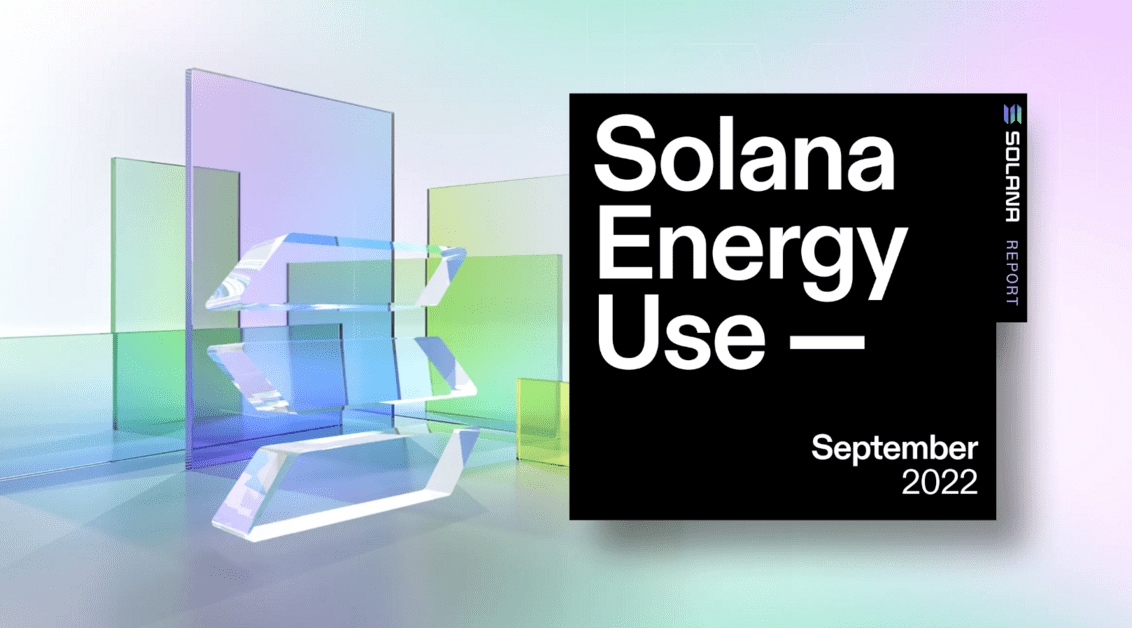
Many believe that Solana is the crypto with the most upside due to its scalability and sustainability. This latter point is strengthened further through Solana’s partnership with Watershed Climate, which sees Solana offset its emissions by funding refrigerant destruction. Through this process, the Solana network has become carbon neutral, with the developers aiming to remain this way over the long term.
Cryptoassets are highly volatile and unregulated. No consumer protection. Tax on profits may apply.
6. IOTA (MIOTA) – Eco-Friendly Network in the ‘Internet of Things’ Space
IOTA differs from the other environmentally-friendly cryptocurrencies on our list due to its novel approach concerning the 'Internet of Things' (IoT). Put simply, IOTA is a distributed ledger that allows devices to interact and transact with one another. As noted by Forbes, IOTA validates transactions through a new technology called ‘the Tangle’.
This technology doesn't require mining and completely removes transaction fees, ensuring it is highly scalable. Due to this, IOTA can be considered one of the most environmentally-friendly cryptocurrencies in 2023, as a recent IOTA blog post noted that a transaction on the network only consumes around 0.00678 Joules.
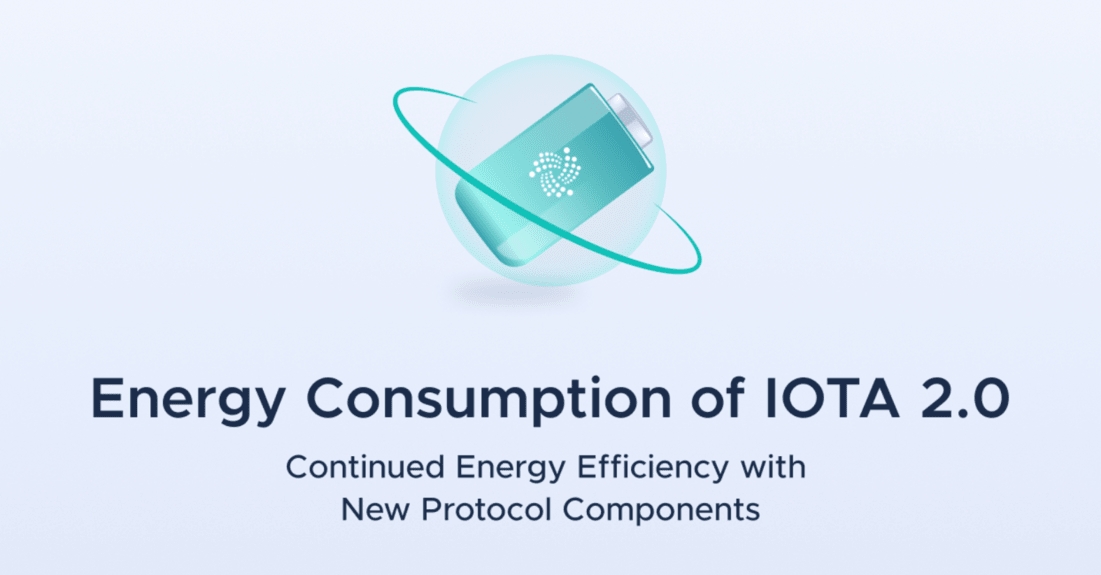
For context, this is less energy than it takes to light a Christmas tree light for one second – highlighting the network’s energy efficiency. What’s more, IOTA’s recent software upgrade means the network now consumes just under 205 TWh of electricity per year, which is about 0.000009% of Bitcoin’s annual energy requirement.
Cryptoassets are highly volatile and unregulated. No consumer protection. Tax on profits may apply.
7. Hedera (HBAR) – Environmentally-Friendly Alternative to Blockchain Technology
Hedera is one of the few environmentally-friendly cryptocurrencies that veers away from blockchain technology, instead opting to use a unique ‘hashgraph’ algorithm. This algorithm was designed by founder Leemon Baird and uses ‘hashes’ instead of blocks to store data. Through this approach, the Hedera network actually becomes faster as more people use it.
This means Hedera is a viable alternative to the best Proof-of-Stake coins since it is highly scalable yet remains eco-friendly. Sustainability is one of the Hedera’s core values, which has prompted the team to purchase carbon offsets every quarter in conjunction with leading social enterprise, Terrapass.

Interestingly, Hedera's team purchases enough carbon offsets to ensure the network is carbon-neutral. For example, the team purchased offsets for 17 tons of CO2 in Q3 2022 – the equivalent of 3.7 passenger vehicles being driven for an entire year. Through this approach, Hedera aims to become the most eco-friendly cryptocurrency alternative to the blockchain.
Cryptoassets are highly volatile and unregulated. No consumer protection. Tax on profits may apply.
8. Chia (XCH) – ‘Green’ Blockchain with Unique Consensus Protocol
Many analysts believe Chia is one of the cryptos with the most potential due to this blockchain's unique consensus algorithm. Instead of using a PoW or PoS protocol, Chia's team has developed its own approach – 'Proof-of-Space-and-Time'. Not only does this approach make Chia more accessible, but it also ensures the network minimizes its energy requirements.
Using Proof-of-Space-and-Time, the Chia blockchain can validate transactions using unused space on HDDs and SDDs. Network participants ‘plot’ 10GBs worth of ‘hashes’ on these storage devices, which are used to verify blocks. According to the Chia website, this approach means that the network uses just 0.16% of Bitcoin’s annual energy consumption.

Moreover, since Chia's consensus protocol utilizes unused disk space, it removes the need for validators to purchase complex computing equipment. This drastically reduces electronic waste while keeping the network's energy requirements to under 0.20 TWh per year.
Cryptoassets are highly volatile and unregulated. No consumer protection. Tax on profits may apply.
9. SolarCoin (SLR) – Innovative Platform Incentivizing Solar Power Generation
SolarCoin occupies a unique position in our list of environmentally-friendly cryptocurrencies since this project focuses solely on solar power. According to Statista, global investments in solar energy technology more than doubled between 2009 and 2019, highlighting the popularity of this energy source.
The team behind SolarCoin aim to make solar energy free by rewarding users with $SLR when they install solar panels. Once the value of $SLR exceeds the cost of producing solar energy, the ‘Solarity' occurs – which is the point when that energy becomes 'free' to create.

SolarCoin will provide one $SLR token per 1 MWh of electricity produced, incentivizing users to become sustainable in their daily lives. Finally, since SolarCoin is hosted on the Energy Web Chain (EWC), transactions are verified using a ‘Proof-of-Authority’ (PoA) protocol – which doesn’t require any mining and is therefore considered energy-efficient.
Cryptoassets are highly volatile and unregulated. No consumer protection. Tax on profits may apply.
10. Polkadot (DOT) – Eco-Friendly Protocol Designed for Interoperability
Polkadot has garnered a reputation as one of the most volatile cryptos on the market yet has remained popular with investors due to its low-power approach. For those unaware, Polkadot is an innovative protocol that promotes interoperability between blockchains. The protocol has a central hub, called the relay chain, that can process the transactions on chains surrounding it.
These surrounding chains are called ‘parachains’, which are essentially blockchains with specific use cases. Since the relay chain handles all verification, developers on these parachains can focus solely on expanding the network rather than its security.
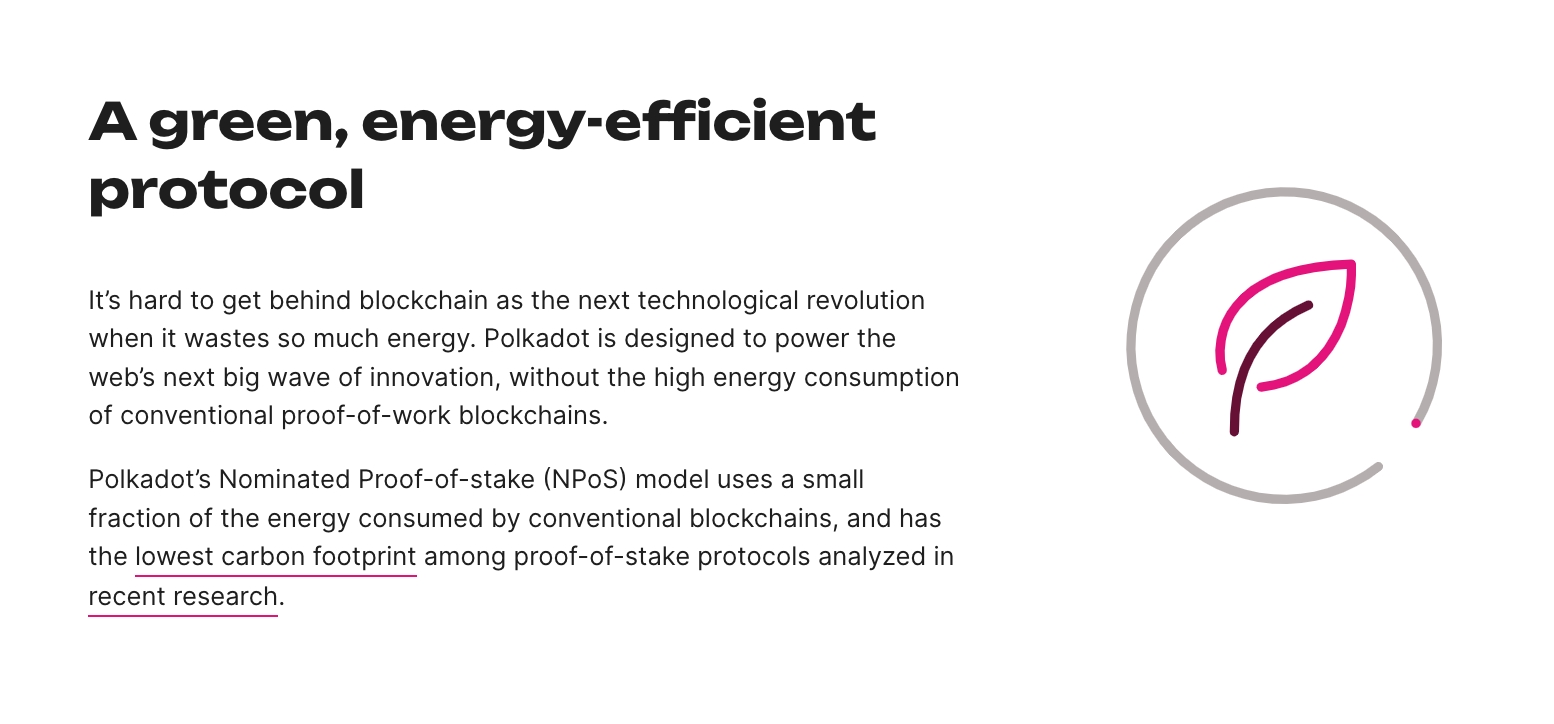
According to Bloomberg, Polkadot has the lowest total electricity consumption and carbon emissions of the six leading PoS chains. What’s more, Polkadot’s innovative Nominated Proof-of-Stake (NPoS) mechanism means that it uses a fraction of the energy that Bitcoin does – highlighting how eco-friendly this project is.
Cryptoassets are highly volatile and unregulated. No consumer protection. Tax on profits may apply.
11. Flow (FLOW) – New Low-Energy Blockchain for NFT Creators
Flow has emerged as one of this year’s top trending cryptos, with this popularity boosted even further in recent weeks due to the network's partnership with Instagram. Through this partnership, Instagram users can post NFTs on their page using the Flow blockchain – which has provided massive publicity for the project.
Much of the Flow development team’s focus is on upcoming NFTs, yet they still ensure the network remains eco-friendly. According to Flow’s website, the network uses just 0.18 GWh of electricity annually. This data has also been verified by Deloitte, highlighting how serious Flow's team is about sustainability.

To put Flow's energy requirements into perspective, minting one million NFTs on the network would use the same energy as driving just one mile in a car. Furthermore, Flow's annual energy consumption is less than that of leading chains like Solana and Polygon, with the team keen to remain in this position over the long term.
Cryptoassets are highly volatile and unregulated. No consumer protection. Tax on profits may apply.
12. Algorand (ALGO) - Carbon-Negative Blockchain with Environmentally-Conscious Founder
Rounding off our list of the most environmentally-friendly cryptocurrencies in 2023 is Algorand. Algorand is a smart contract-enabled blockchain founded by MIT professor Silvio Micali. Micali won the Turing Award back in 2012 and has ensured the Algorand network employs eco-friendly technology to remain sustainable.
Algorand uses a unique ‘Pure Proof-of-Stake’ (PPoS) consensus mechanism, meaning that each transaction on the network uses just 0.0000004 kg of CO2. This means Algorand’s annual energy requirements are roughly the same as just seven average households.

In addition, Algorand’s team actively offset the network's carbon footprint by using smart contracts to buy carbon credits. Through this process, Algorand has become carbon negative on a net basis, making this one of the most eco-friendly cryptocurrencies on our list.
Cryptoassets are highly volatile and unregulated. No consumer protection. Tax on profits may apply.
What Makes a Cryptocurrency Eco-Friendly?
Now that we’ve highlighted which eco-friendly cryptocurrencies are worth checking out, let’s take a closer look at what these cryptos actually do. Many new cryptocurrency projects claim to be eco-friendly - yet there’s a crucial difference between those that aim to be and those that actually are.
There’s no escaping the fact that blockchain networks consume electricity. Since there’s no way around this, leading blockchains have continued to innovate over the past few years and develop ways in which they can limit their electricity use. By limiting their electricity requirements, these blockchains can reduce (or eradicate) their carbon footprint.

The primary way developers can make their projects eco-friendly is by using an alternative to the Proof-of-Work (PoW) consensus protocol popularized by Bitcoin. According to a recent report by The White House, the Bitcoin network accounts for between 60% and 77% of the total global crypto-asset electricity usage.
Naturally, Bitcoin's huge energy requirements have created a demand for alternatives, which is where these eco-friendly projects come in. Most use a consensus protocol called 'Proof-of-Stake' (PoS), which removes the need for the energy-intensive computing hardware used during the mining process. In turn, this drastically reduces the electricity requirements for PoS chains.
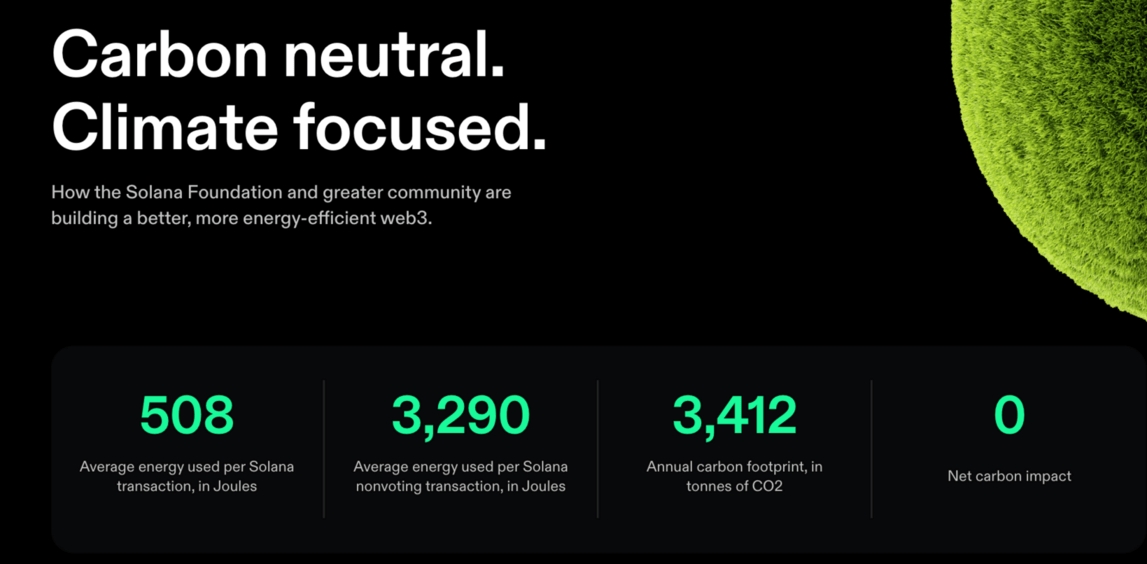
Although many of the best altcoins now employ a PoS protocol, some even take things one step further. For example, Solana uses a ‘hybrid’ protocol that allows the network to be eco-friendly whilst remaining highly scalable. Solana's team also actively reduces the network’s carbon footprint by funding refrigerant destruction – one of the best ways to offset CO2 emissions.
So, in a nutshell, the main characteristic of eco-friendly cryptos is that they employ technologies designed to reduce electricity consumption. This approach has become more prevalent recently, seeing PoW projects like Bitcoin and Litecoin receive less attention. Given the growing need for positive environmental change, this trend shows no signs of slowing.
Why Environmentally-Friendly Cryptocurrency is Important
Many of the best future cryptocurrency projects will likely focus heavily on sustainability – yet why is this so important? To answer this question, detailed below are four reasons why eco-friendly cryptos will continue to be vital over the long term:
Is Appropriate for ESG-focused Investors
Eco-friendly cryptos are crucial since they offer a viable alternative for investors interested in sustainable projects. These investors have had their hands tied in recent years, as most projects were energy-intensive compared to today's networks, yet this has begun to change.
ESG-focused investors now have an array of investment opportunities since leading cryptos like Tezos, Solana and Ethereum all utilize energy-efficient technology. What's more, as these cryptos grow in popularity, other new projects will likely follow suit and take a sustainable approach – thereby boosting the positive environmental impact.
Helps Reduce Carbon Dioxide Emissions
According to the Environmental Protection Agency (EPA), 65% of global greenhouse gas emissions are attributed to carbon dioxide from fossil fuels and industrial processes. This means that electricity generation is a considerable burden on the environment, which is why energy-intensive cryptos like Bitcoin have got such a bad rap.
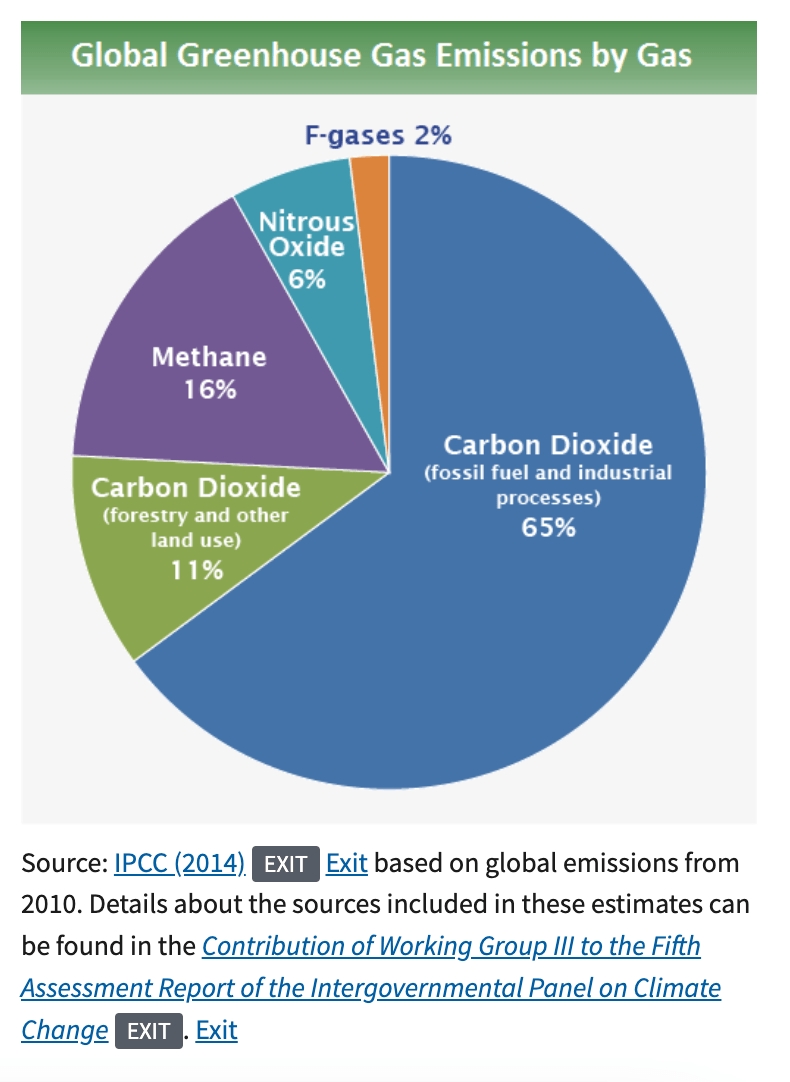
However, environmentally-friendly cryptocurrencies look to reverse these adverse effects by limiting their energy requirements. In addition, many cryptos also remove their carbon footprint by purchasing offsets – highlighting how important these projects are in the battle against climate change.
Promotes Innovation in the Crypto Market
The rise of eco-friendly cryptocurrencies has also helped the market as a whole. Due to the competitive nature of the market, whenever a project leaps ahead of the others in terms of sustainability, it naturally prompts those that have been left behind to look for ways that they can improve.
On a macro level, this enables the entire market to become more energy-efficient, leaving energy-intensive projects by the wayside. If this trend continues over the long term, we’ll likely see new and exciting technologies emerge that improve on those of today.
Generates Good Publicity for Cryptocurrencies
Finally, as more and more cryptos become eco-friendly, it helps to change people's perception of the crypto market. Due to Bitcoin's size and pop culture appeal, most people focus solely on its environmental impact rather than considering the good done by other projects.

However, as these eco-friendly cryptocurrencies continue to grow, less attention will be paid to BTC and more will be paid to these sustainable projects. In turn, this should naturally create positive publicity for the crypto market as a whole – which benefits all stakeholders.
How to Find Eco-Friendly Cryptocurrencies
Some of the fastest-growing cryptocurrency projects on the market utilize eco-friendly technologies, making them appealing to environmentally-conscious investors. Those looking to get involved in these projects can identify them using the following approaches:
Analyze Industry Reports
A great way to find eco-friendly cryptos is to look for industry reports that analyze the energy usage of leading blockchains. A great place to start is with the Crypto Carbon Ratings Institute (CCRI), which regularly authors reports on blockchain networks, tokens, and NFTs.

By reviewing the information in reports like those authored by the CCRI, investors can gain verifiable insight into which cryptos are doing the most for the environment – and which aren’t.
Research the Underlying Technology
Many of the best metaverse coins use cutting-edge technologies, and eco-friendly cryptos are no different. Thus, investors looking to find these cryptos can keep tabs on the latest technological innovations and seek out projects that utilize them.
For example, the Chia network's 'Proof-of-Space-and-Time' consensus algorithm is a relatively new innovation that offers an alternative to PoW and PoS mechanisms. Furthermore, some blockchains look to improve already-established technologies – an example being Algorand’s Pure Proof-of-Stake consensus.
Review the Project’s Website/Whitepaper
Like when searching for the best upcoming ICOs, investors looking to identify eco-friendly cryptos can review the project's website and whitepaper. Both of these elements are great resources for learning about the project and the values the development team holds.

The whitepaper is especially important since this document will detail the technology underlying the project. Thus, by reviewing the whitepaper thoroughly, investors can clearly see whether the project is sustainable or not.
Keep Tabs on Social Media Platforms
Finally, investors can also use Twitter, Reddit, and Instagram to keep tabs on various crypto projects and identify which have eco-friendly principles. Due to the importance of these principles, projects that aim to improve the environment will often display their efforts on social media for all to see.
Furthermore, some projects may even quote third-party institutions that have reported positive information about them. Thanks to this, it’s relatively easy for investors to see which projects are actively helping the environment.
Most Eco-Friendly Cryptocurrencies – Conclusion
In summary, this guide has taken an in-depth look at 12 of the most eco-friendly cryptocurrencies on the market, exploring how they reduce their energy requirements and make a positive impact on the global environment.
Many of these eco-friendly cryptos can be purchased using eToro – one of the world's top online trading platforms. eToro serves more than 28 million clients worldwide and is regulated by tier-one entities like FinCEN, FINRA, CySEC, and the FCA. Moreover, eToro allows clients to open positions from just $10, with full support for credit/debit card, PayPal, Skrill, and Neteller deposits.
However, our top choice for most eco-friendly crypto is C+Charge, a newly-launched presale project that will incentivize electric vehicle ownership by offering carbon credits as rewards while they recharge. The C+Charge mobile app will also remove the inconvenience of recharging by offering detailed information on the nearest charging stations, waiting times and pricing information.
An alternative project is IMPT, which is now on exchanges and set for a breakout in price in 2023.
FAQs
What is an environmentally-friendly cryptocurrency?
Most market participants define environmentally-friendly cryptocurrency projects as those that actively limit their energy requirements, reducing their contribution to global warming. However, many of these projects take things one step further and purchase carbon credits to offset their emissions entirely.
What are the most eco-friendly cryptocurrencies?
Two of the most eco-friendly cryptocurrencies on the market right now are C+Charge and IMPT. The two projects are making carbon credit ownership more accessible - in different ways - and are expected to see huge growth in 2023.
Which crypto has the lowest carbon footprint?
Through our research and analysis, we’ve found that Tezos has one of the lowest carbon footprints in the crypto market. The Tezos network consumes just over 113,200 kWh per year, which is around the same amount as just 10 US households.














